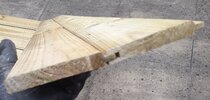Well, the stuff in the second photo is a bit different to the first photo you posted!
Personally, I
do think you are over thinking it. I also think that you've got the wrong end of the stick about what "heartwood" actually is (see below), and your understanding hasn't been helped by referencing an American web site where the author takes waney edge boards (which are pretty much always sawn hardwood) and where he clearly doesn't understand what heartwood is either (he actually means growth rings - yes, I did skim the site, that's 10 minutes I'll never get back):
and then rips them down into straight planks:
which isn't the same material you are using. In hardwood, the heartwood is found between the pith at the very centre of the tree and the sapwood near the outer edges, just below a thin layer of cambium and the bark. The sapwood is the part of the tree which actually grows, whereas the heartwood, whilst not dead, is no longer growing. It provides strength to the structure of the tree:
So to me talking about "putting the heartwood facing outwards" is just plain wrong, especially when you consider that when softwood is sawn it is invariably sawn T&T (or through and through), thus:
I chose that diagram to illustrate not only through and through sawing, but also the effect of moisture on grain orientation. The article in your link states:
'Cupping' can be mitigated by fixing the heartwood on the outside so that the screws/fixings clamp the board to the batten keeping it as straight as possible.
When what he
actually means is
growth rings.
If you look at the top edge of the timber, it's the
growth rings which are the important bit, and if you want to go that way you'll need to orient your boards as above to get all the boards to cup outwards equally. But here's the rub - at college I was taught two alternative methods; in the first all the boards are set-up to cup outwards (or upwards), in the other method you alternate the boards so one cups outwards, the next inwards, the next outwards and so forth. Take your pick because in reality, it doesn't really matter how you do it.
One thing I would say is beware of taking what you read on an American website as gospel. The UK is a different country, sometimes with different processing techniques and much higher safety standards) and sometimes with different terminology. So it doesn't always translate
Anyone who really wants a detailed explanation of wood movement, I thoroughly recommend R, Bruce Hoadley's book
"Understanding Wood: A Craftsman's Guide to Wood Technology" which is widely considered to be one of the most comprehensive books written on the subject and was a standard college texts when I was doing a qualification a number of years back - but it's hardly bedtime reading
BTW good luck with the gate


